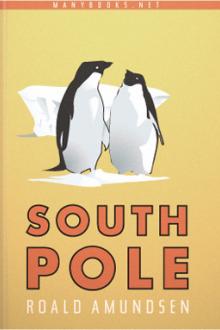The North Pole by Robert E. Peary (room on the broom read aloud .TXT) 📕

- Author: Robert E. Peary
- Performer: -
Book online «The North Pole by Robert E. Peary (room on the broom read aloud .TXT) 📕». Author Robert E. Peary
The worst of the ice fighting did not begin immediately, and the new members of the expedition, MacMillan, Borup, and Dr. Goodsell, were at first much interested in watching the Eskimo women at their sewing. They sit on anything that is convenient, a chair, a platform, or the floor. In their own quarters they remove their footgear, put up one foot, and hold one end of the fabric between their toes, sewing a seam over and over from them, instead of toward them, as our women do. The foot of an Eskimo woman is a sort of third hand, and the work is gripped between the great toe and the second toe.
The Eskimo women have great confidence in their own skill at garment-making, and they take suggestions from the inexperienced white men with a good-natured and superior tolerance. When one of the northern belles was shaping a garment for Bartlett to wear on the spring sledge journey, he anxiously urged her to give him plenty of room. Her reply was a mixed Eskimo and English equivalent for:
"You just trust me, Captain! When you get out on the road to the Nor Pol, you'll need a draw-string in your jacket, and not gussets." She had seen me and my men come back from previous sledge journeys, and she knew the effect of long continued fatigue and scanty rations in making a man's clothes fit him loosely.
The Eskimos had the run of the ship, but the port side of the forward deck house was given to them entirely. A wide platform three or four feet high, made of packing boxes, was placed around the wall of the deck house for them to sleep on. Each family had its own quarters, partitioned off by planks, and screened in front by a curtain. They cooked their own meat and whatever else they desired, though Percy, the ship's steward, provided them with tea and coffee. If they had baked beans, or hash, or anything of that kind from the ship's store, it was cooked for them by Percy; and he also furnished them with his famous bread, which for lightness and crispness is unsurpassed in the round world.
The Eskimos seemed always to be eating. There was no table for the crowd of them, as they do not incline to regular meal hours; but each family ate by itself, as appetite dictated. I gave them pots, pans, plates, cups, saucers, knives, forks, and oil stoves. They had access to the ship's galley, day and night; but Percy was always amiable, and the Eskimos at length learned not to wash their hands in the water in which he purposed to boil meat.
The third day out the weather was villainous. It rained steadily, and there was a strong southerly wind. The group of dogs on the main deck stood about with low, dejected heads and dripping tails. Only at feeding time did they take courage even to fight or snap at one another. Most of the time the ship was stationary, or drifting slowly with the ice toward the mouth of Dobbin Bay. When at last the ice loosened, we made about ten miles in open water—then the wheel rope broke, and we had to stop for repairs, unable to take advantage of the stretch of water still before us. The captain's remarks when the strands of that cable parted I will leave to the imagination of the reader. Had the accident occurred at a time when the ship was between two big floes, the fortress of the North Pole might still remain uncaptured. It was after midnight before we got under way, and half an hour later we were stopped again by the impassable ice.
On the fourth day we lay quiet all day long, with a slight breeze from Princess Marie Bay setting us slowly eastward; but, as the sun was shining, we utilized the time in drying our clothing, wet and soggy from the almost continuous rain and snow of the previous two days. As it was still summertime in the Arctic, we did not suffer from cold. The pools between the ice floes were slowly enlarging, and at nine in the evening we were on our way again, but at eleven we ran into a thick fog. All night we bored and twisted through the ice, which, though thick, was not heavy for the Roosevelt, and only once or twice we had to back her. An ordinary ship could have made no headway whatever.
Wardwell, the chief engineer, stood his eight-hour or twelve-hour watch the same as his assistants, and during the passage of these dangerous channels he was nearly always in the engine-room, watching the machinery to see that no part of it got out of order at a crucial moment—which would have meant the loss of the ship. When we were between two big floes, forcing our way through, I would call down the tube leading from the bridge to the engine-room:
"Chief, you've got to keep her moving until I give you word, no matter what happens."
Sometimes the ship would get stuck between the corners of two floes which were slowly coming together. At such a time a minute is an eternity. I would call down the tube to Wardwell, "You've got to jump her now, the length of fifty yards," or whatever it might be. And I could feel the ship shaking under me as she seemed to take the flying leap, under the impulse of live steam poured directly from the boilers into the fifty-two-inch low-pressure cylinder.
The engines of the Roosevelt have what is called a by-pass, by which the live steam can be turned into the big cylinder, more than doubling the power of the engines for a few minutes. This simple bit of mechanism has saved us from being crushed flat by the ice on more than one occasion.
The destruction of a ship between two ice floes is not sudden, like her destruction by a submarine mine, for instance. It is a slow and gradually increasing pressure from both sides, sometimes till the ice meets in the vitals of the ship. A vessel might stay thus, suspended between two floes, for twenty-four hours—or until the movement of the tides relaxed the pressure, when she would sink. The ice might open at first just sufficiently to let the hull go down, and the ends of the yards might catch on the ice and break, with the weight of the water-filled hull, as was the case with the ill-fated Jeannette. One ship, in the Gulf of St. Lawrence, was caught in the ice and dragged over the rocks like a nutmeg over a nutmeg grater. The bottom was sliced off as one would slice a cucumber with a knife, so that the iron blubber tanks in the hold dropped out of her. The ship became nothing but the sides and ends of a box. She remained some twenty-four hours, gripped between the floes, and then went down.
On the 22d of August, the fifth day, our lucky stars must have been working overtime; for we made a phenomenal run—more than a hundred miles, right up the middle of Kennedy Channel, uninterrupted by ice or fog! At midnight the sun burst gloriously through the clouds, just over Cape Lieber. It seemed a happy omen.
Could such good fortune continue? Though my hopes were high, the experience of former journeys reminded me that the brightest coin has always a reverse side. In a day we had run the whole length of Kennedy Channel, and immediately before us there was only scattered ice. But beyond lay Robeson Channel, only some thirty miles away, and the navigator who knows Robeson Channel will never be sanguine that it has anything good in store for him.
Soon we encountered both ice and fog, and, while working slowly along in search of an opening, we were forced clear across to the Greenland coast at Thank God Harbor, the winter quarters of the Polaris in 1871-72. I have mentioned the lane of water which often lies at ebb tide between the land and the moving central pack; but the reader must not fancy that this is an unobstructed lane. On the contrary, its passage means constant butting of the smaller ice, and constant dodging of larger pieces.
Of course the steam is up at all times, ready, like ourselves, for anything at a moment's notice. When the ice is not so heavy as to be utterly impenetrable, the ship under full steam moves back and forth continually, butting and charging the floes. Sometimes a charge will send the ship forward half her length, sometimes her whole length—sometimes not an inch. When, with all the steam of the boilers, we can make no headway whatever, we wait for the ice to loosen up, and economize our coal. We do not mind using the ship as a battering ram—that is what she was made for; but beyond Etah coal is precious, and every ounce of it must yield its full return of northward steaming. The coal at present in our bunkers was all that we should have until our return the following year, when the Peary Arctic Club would send a ship to meet us at Etah.
It must be remembered that during all this time we were in the region of constant daylight, in the season of the midnight sun. Sometimes the weather was foggy, sometimes cloudy, sometimes sunny; but there was no darkness. The periods of day and night were measured only by our watches—not, during the passage of these channels, by sleeping and waking, for we slept only in those brief intervals when there was nothing else to do. Unresting vigilance was the price we paid for our passage.
Bartlett's judgment was reliable, but the cabin had no attraction for me when the ship and the fortunes of the expedition were swaying in the balance. Then, too, when the ship was butting the ice, the shock of the impact would have made Morpheus himself sit up and rub his eyes every few minutes.
CAPTAIN BARTLETT IN THE CROW'S NEST
Owing to the stupendous and resistless character of the heavier ice, a ship would be utterly helpless if she were ever caught fairly and squarely between two giant floes. In such a case there would be no escape for any structure which man could design or build. More than once a brief nip between two big blue floes has set the whole one hundred and eighty-four-foot length of the Roosevelt vibrating like a violin string. At other times, under the pressure on the cylinders of the by-pass before described, the vessel would rear herself upon the ice like a steeplechaser taking a fence. It was a glorious battle—this charging of the ship against man's coldest enemy and possibly his oldest, for there is no calculating the age of this glacial ice. Sometimes, as the steel-shod stem of the Roosevelt split a floe squarely in two, the riven ice would emit a savage snarl that seemed to have behind it all the rage of the invaded immemorial Arctic struggling with the self-willed intruder, man. Sometimes, when the ship was in special peril, the Eskimos on board would set up their strange barbaric chant—calling on the souls of their ancestors to come from the invisible realm and





Comments (0)